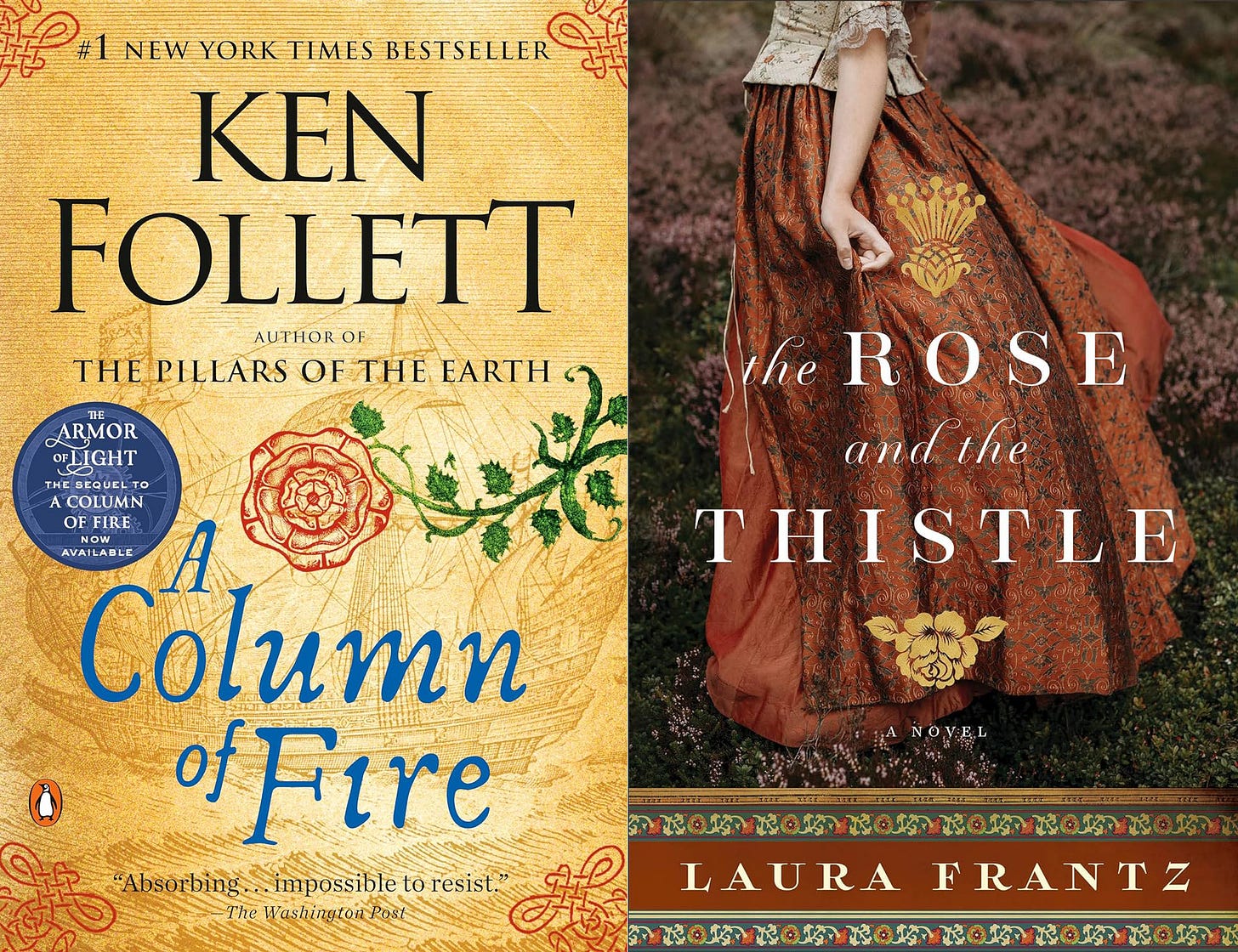Those Pesky Stuarts
The last two novels I read had an unplanned historical continuity.
The first, Ken Follett’s A Column of Fire, runs from 1558 to 1606 during which the House of Tudor was fending off the House of Stuart, both before and throughout the reign of Queen Elizabeth I. I chipped away at this tome while getting my head sorted out from personal events.
I then, somewhat randomly, picked up The Rose and the Thistle at the library. I was scanning Christian novels, looking for ways to integrate literary quotes and paraphrases into my own work. I figured most Christian fiction would make various forms of reference to and integration of scripture. Although Ms. Frantz’s book is a romance, something I rarely read, I liked the cover. I checked the Amazon reviews: 4.6 stars out of 614 reviews. It looked like a good resource from a pro.
Until I began reading, I didn’t realize The Rose and the Thistle is set in 1715 in the context of the House of Hanover putting down the last Jacobite efforts to restore the House of Stuart—still at it over 100 years after Follett’s A Column of Fire ends.
So, here was a surprising historical overlap between two vastly different stories.
A little Compare/Contrast for you:
Both, of course, are set in the context of Catholic vs. Protestant conflict.
Ken Follett’s A Column of Fire (Viking 2017) is listed as Book 3 of 5 in his Knightsbridge series, although this is chronologically book #4 if you count the prequel: The Evening and the Morning.
A Column of Fire follows the life of Ned Willard, spy for Queen Elizabeth, as he works to put her on the throne and then keep her there. He has two personified antagonists, 1) Rollo Fitzgerald, the brother of his first love—a financially ruined Catholic turned monk/spy supporting the Stuarts, the Spanish invasion, and the Gunpowder Plot, 2) Pierre Aumande, a blood-thirsty scoundrel supporting the Guise family’s efforts to retain power in France. It also traces the two women in Ned’s life, one Catholic, one Protestant, both courageous in their beliefs and actions.
The story swirls between England, Scotland, France, the Caribbean, etc. It encompasses the French religious wars, the long imprisonment of Mary Queen of Scots and her eventual execution, the failure of the Spanish armada, all the way up the Gunpowder Plot.
This plot is world history personalized.
A complex story tracking big history through the lives of powers behind the powers.
Covering a nearly 50 year scope.
Many point of view characters.
Scrappy regular people shaping big events.
Laura Frantz’s The Rose and the Thistle (Revell 2023) is a classic clean historical romance: sharp-witted damsel made dependent upon the bachelor lord of a large estate. In this case, Lady Blythe Hedley, a Catholic and only daughter of the Duke of Northumbria, is cast upon the charity of Everard, Earl of Wedderburn, a Scottish Protestant and retired military hero. While her father works to support the Jacobite (Stuart) Rising, her host must try to honor his own father’s promise made to the duke—to protect Blythe from the consequences of her father’s clandestine activities. The story takes place between Northumbria and various sites in Scotland.
This plot is tight and personal, set against historical events.
The larger history undergirds the plot, but these characters are not driving these events. They are trying to navigate currents they cannot direct.
The narrow focus allows for more immersive experience in the physical world of the story.
Having only two point of view characters allows for more in-depth exposure to their internal workings and emotions.
The entire story takes place within a few months.
I would say I preferred Follett’s broader historical scope, it’s more my kind of story, although at the character level, those in my Work in Progress are more like Ms. Frantz’s—trying to survive the sweeping events they have little personal control over.
As noted, I rarely read romance—too predictable, I suppose, but I enjoyed this one. I read Ms. Frantz’s book quickly. She writes beautifully without bogging the story down with too much froufrou.
I balked a little at a certain plot point, but won’t spoil that here.
I also felt the romantic tension would have worked better if she’d kept the story to Bylthe’s point of view rather than including Everard’s (as did Ms. Austen in Pride and Prejudice).
Suspense can work two ways, 1) the reader not knowing anything more than that of the main character, sharing their ignorance—Oh, no! What’s behind that door? or 2) the reader knowing more than the POV character and wanting to scream at them—Don’t go in the basement! As it was, I felt I wanted to smack Bylthe for being a dullard where Everard was concerned. If I hadn’t known his POV, I might have been more convinced of hers.
But these are minor observations in an otherwise elegantly written text.
And, yes, this text answered most of my style/formatting questions on how to integrate references to other literature in fiction. She even includes multiple Shakespearean quotes, which will help me find ways to finesse Ovid and Homer into the minds and dialog of my characters.





